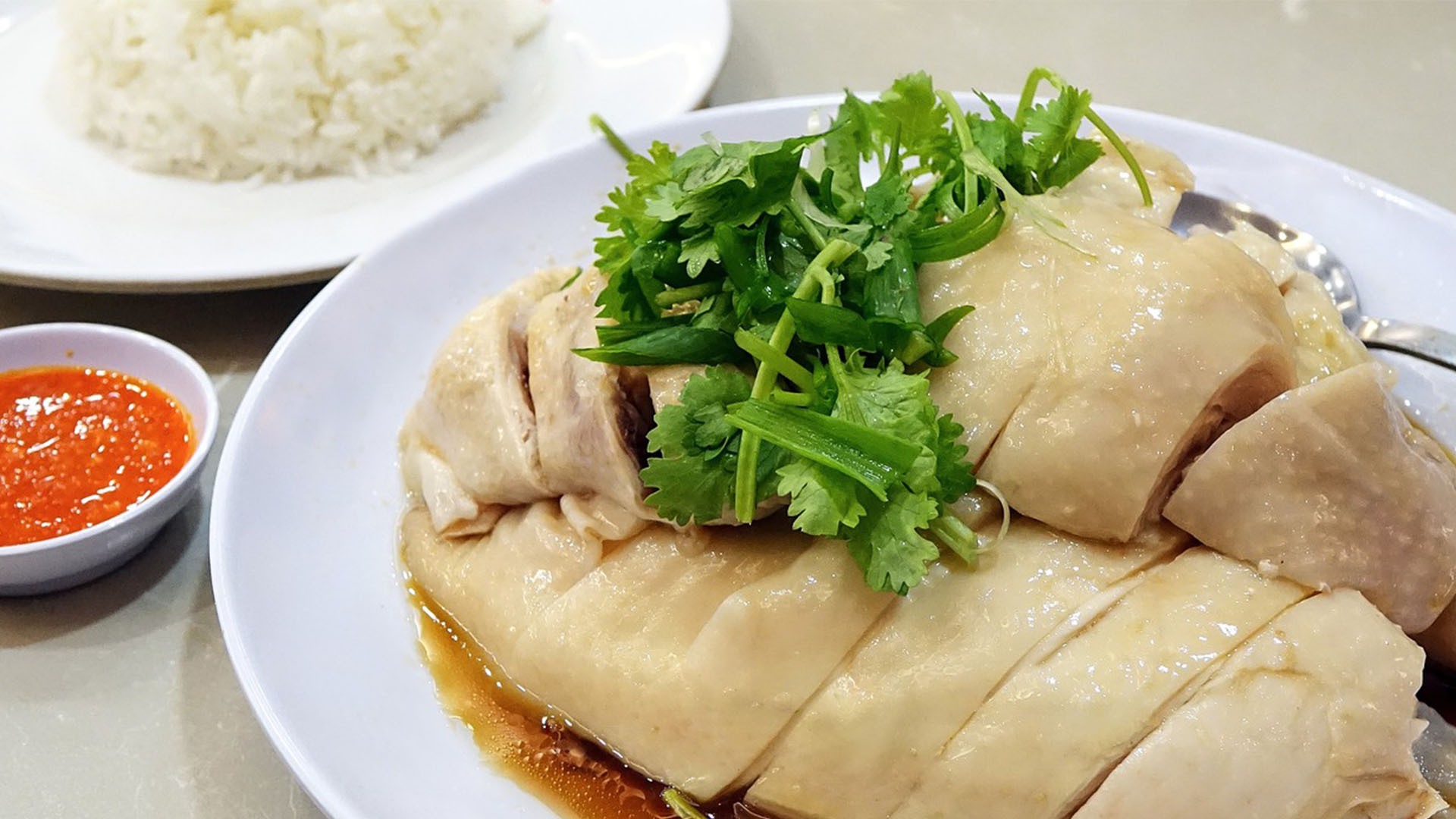Singapore, a vibrant and multicultural island nation, has a rich culinary heritage that reflects its diverse population. At the heart of this food culture is a dish that stands out as the unofficial national dish, captivating both locals and tourists with its distinct flavour and humble origins. That dish is none other than Hainanese Chicken Rice, a seemingly simple yet delicious meal that has become synonymous with Singaporean cuisine.
Hainanese Chicken Rice is derived from early Chinese immigrants from Hainan Island, who adapted the recipe to suit local tastes and ingredients. It consists of tender, poached chicken served with fragrant rice cooked in chicken stock, accompanied by a “power” chili sauce and dark soy sauce. This dish can be found everywhere in Singapore, from modest hawker stalls to luxurious hotels, and has been celebrated as the essence of the nation’s culinary spirit.
Key Takeaways
- Hainanese Chicken Rice is Singapore’s unofficial national dish, loved by both locals and tourists for its distinct flavor and humble origins.
- The dish has its roots in the early Chinese immigrants from Hainan Island, who adapted the recipe to suit local tastes and ingredients.
- Singaporean cuisine is a fusion of diverse cultures, showcasing a vibrant and rich culinary heritage traced back to its historical connections as an international shipping port.
Singapore’s Food Culture
Influence of Different Cultures
Singapore’s food culture is a rich tapestry, influenced by the diverse ethnic groups that make up the population. These groups include the Malays, Chinese, Indians, and Peranakan communities, among others. Migrants from various parts of Southeast Asia over the years have introduced their traditional dishes and cooking styles, resulting in a unique blend of flavours and culinary techniques found in Singaporean cuisine.
The Chinese group, in particular, has a strong influence on the local food, with various dialect groups such as the Cantonese, Hokkien, and Teochew contributing distinct cooking styles and flavours. India’s diverse culinary traditions have also shaped Singapore’s food culture, with dishes such as curry and biryani becoming beloved staples.
Popularity of Hawker Centers
One of the key features of Singapore’s food culture is the popularity of hawker centres. Hawker centres are open-air food courts with multiple stalls selling a variety of affordable and delicious local dishes. They serve as a social hub for Singaporeans from all walks of life and reflect the multicultural makeup of the nation.
In these hawker centres, visitors can find a wide selection of dishes that showcase the unique flavours of the various cultures present in Singapore. Popular offerings include items such as Hainanese chicken rice, roti prata, laksa, and satay. These centres are not only a significant part of the local food scene but also a testament to the harmony and cultural exchange between the different communities in Singapore.
Defining Singapore’s National Dish
Chicken Rice
Hainanese Chicken Rice is considered one of Singapore’s most cherished dishes. Its simplicity and delicious combination of poached chicken and fragrant rice have made it a staple in Singaporean hawker centres. The dish is a result of a mix of Hainanese and Cantonese cultures, with the chicken being poached whole and then quickly stopped from cooking by placing it in an ice bath. The rice is seasoned with chicken oil made from chicken fat and cooked in the poaching liquid. The dish is often served with cucumber slices, light soy sauce, and house-made citrusy chilli and ginger.
Laksa
Laksa is another popular dish in Singapore, representing the blend of Chinese and Malay culinary influences. It consists of a spicy coconut milk-based curry broth, noodles, and various ingredients like fishcake, seafood, and vegetables. The rich and flavorful broth is made with lemak, a mixture of spices and coconut milk, giving the dish its characteristic creamy and spicy taste. Laksa embodies the multi-ethnic essence of Singaporean cuisine and is enjoyed by locals and tourists alike.
Chilli Crab
Chilli Crab is a favourite among Singaporeans, representing the country’s love for seafood and bold flavours. This dish features crabs cooked in a thick, sweet, and spicy chilli sauce, which sometimes includes a hint of black pepper as well. The sauce is made with a base of tomatoes and is thickened with egg, creating a rich and tangy taste that complements the tender crab meat perfectly. Chilli Crab is often served with steamed or fried buns called mantou, which are great for soaking up the delicious sauce. Its popularity in Singapore demonstrates the nation’s love for flavorful and exciting dishes.
Key Ingredients in Singaporean Cuisine
Essential Spices
In Singaporean cuisine, spices play a vital role in creating unique and flavorful dishes. Some common spices include sambal, a chili paste made from a mixture of chilies, shrimp paste, garlic, ginger, and other ingredients. This is often used in dishes like curry and satay. Another essential spice is the curry powder, consisting of a blend of spices like coriander, cumin, turmeric, and chili powder, which is extensively used in dishes like mutton curry and Katong Laksa.
Singapore’s rich history of migrants from various regions brought along their culinary traditions, influencing the use of spices in the local cuisine. For instance, lemak (coconut milk) and palm sugar are common ingredients in many desserts, like the emblematic glutinous rice dish.
Singaporean Seafood
Seafood makes up an essential part of Singaporean cuisine. With both saltwater and freshwater sources available, there is an abundance of fish, shellfish, and crustaceans, such as prawns and crabs. One of the most iconic seafood dishes is the Chilli Crab, created during the 1950s in East Coast restaurants. Another famous dish is the Black Pepper Crab. Both dishes use a thick, sweet, and savory sauce that includes chilli sauce or dark soy sauce as the base.
Sauces and Flavorings
Singaporean cuisine features a wide array of sauces and flavorings to enhance dishes with distinct taste profiles. Some of the common ingredients include:
- Garlic and onions: These are widely used in many dishes to provide a savory and aromatic base.
- Chili sauce: A vital component in dishes like Chilli Crab and Katong Laksa, chili sauce provides a perfect balance of spice and tanginess.
- Dark soy sauce: This umami-rich condiment is used in multiple dishes, including Hainanese chicken rice, to provide depth of flavor and color.
- Sambal: As mentioned earlier, this spicy paste is an essential ingredient used in various dishes like satay and curry.
In sum, Singaporean cuisine relies on a dynamic combination of spices, seafood, and sauces to create its internationally renowned dishes. The fusion of different culinary traditions, thanks to the diverse migrant history of Singapore, has led to an amalgamation of flavors that are unique and unmistakably Singaporean.
Iconic Singaporean Dishes and Snacks
Roti Prata and Kaya Toast
Roti Prata, a popular Indian-influenced dish, can be found in many hawker centers and food courts. This crispy and fluffy flatbread is served with a side of curry for dipping. Kaya Toast, on the other hand, is a well-loved Singaporean snack that features slices of bread slathered with a fragrant kaya jam made from coconut milk and pandan leaves. Kaya Toast is often enjoyed during breakfast or tea time, and can be found at local coffee shops or food centers.
Bak Kut Teh and Mee Pok
Bak Kut Teh, which literally means “meat bone tea,” is a comforting Chinese soup made from pork ribs simmered in a rich broth flavored with herbs and spices. The soup is often enjoyed with a side of white rice and fried youtiao (dough fritters). Mee Pok, on the other hand, is a Chinese noodle dish featuring egg noodles tossed in a spicy sauce and served with ingredients like minced pork, fish balls, or mushrooms. Both Bak Kut Teh and Mee Pok can be found at hawker centers, food courts, and local eateries.
Hokkien Mee and Mee Siam
Hokkien Mee is a popular noodle dish that is a fusion of Chinese and Malaysian cuisines. It consists of stir-fried yellow and rice noodles, tossed with shrimp, squid, and pork, served with a side of sambal chilli sauce, making it a satisfying and flavorful dish. Mee Siam is another noodle dish, featuring thin rice vermicelli noodles served in a sweet and tangy gravy made from tamarind, dried shrimp paste, and various spices. It is often garnished with ingredients like hard-boiled eggs, bean sprouts, and lime. Both dishes can be enjoyed at local hawker centers and food courts.
In addition to these main dishes, Singapore is also known for its wide array of snacks and side dishes. For example, Wenchang chicken, a tender and juicy poached chicken dish, is a popular accompaniment to Hainanese chicken rice. Yam paste, a sweet dessert made from steamed yam and sugar, is another local favorite. Ikan bilis, or dried anchovies, are often added to Nasi Lemak dishes for a crunchy texture and bold flavor.
Singapore’s culinary scene is a melting pot of cultures and flavors, making it a food lover’s paradise. From iconic dishes like Roti Prata, Kaya Toast, Bak Kut Teh, and Mee Pok to flavorful noodle dishes like Hokkien Mee and Mee Siam, there is something to suit every palate. Be sure to explore local hawker centers like Maxwell Food Centre for an authentic taste of these dishes and more, such as Mee Goreng, Chai Tow Kway, Nasi Padang, and Nasi Lemak with mud crabs. And if you’re looking for a taste of history, visit Raffles Hotel for their famous Singapore Sling cocktail.
Exploring Singapore through Its Food
Singapore is well-known for its vibrant food scene, which showcases a diverse range of flavors and influences from neighboring countries such as China, India, Malaysia, and Indonesia. This melting pot of cultures is reflected in the rich tapestry of Singaporean cuisine, offering travelers a unique and unforgettable gastronomic experience.
One of the key aspects of Singapore’s food culture is its hawker centers, where food stalls serve up mouthwatering dishes at affordable prices. These bustling marketplaces have become a cornerstone of Singaporean life, with locals and tourists alike queuing up to savor authentic delicacies prepared by skilled chefs. Thanks to its strategic location as an international shipping hub, Singapore has embraced this culinary diversity over the years, as evidenced by an array of dishes that cater to various tastes and preferences.
Among the many dishes available, the iconic Hainanese chicken rice is often considered Singapore’s unofficial national dish. This delicious and flavorful meal has its roots in both Chinese and Malaysian cuisines and has evolved over time to become an integral part of the Singaporean dining experience. Its popularity has even reached international levels, with many high-end hotels, such as the Raffles Hotel, offering this aromatic dish on their menu.
In addition to Hainanese chicken rice, travelers can enjoy a plethora of other regional dishes that showcase the diversity of Singaporean cuisine. Some examples include:
- Laksa: A spicy noodle soup combining Chinese and Malaysian influences, featuring creamy coconut milk broth, rice noodles, and a variety of toppings like shrimp, fish, or tofu.
- Roti Prata: A thin and flaky Indian-influenced flatbread, served with a side of spicy curry for dipping.
- Satay: Skewered and grilled meat, such as chicken, beef, or lamb, marinated in bold spices and served with a flavorful peanut sauce, hailing from Indonesian and Malaysian culinary traditions.
Singapore’s food scene goes beyond simple flavors and ingredients; it embodies the multicultural spirit of the nation, making it an essential aspect of any travel experience. As visitors explore the vibrant culinary landscape, they will undoubtedly feel the warmth and dedication of the people who create these delectable dishes, highlighting Singapore’s ethos of inclusivity, innovation, and connection.
The Historical Journey of Chicken Rice to Becoming Singapore’s Staple
The Humble Beginnings of Chicken Rice in Hidden Alleys
Hainanese chicken rice originated from a traditional Hainanese dish called wen chang ji, which was poached chicken paired with a ginger-garlic dip. The dish later evolved when a Hainanese street hawker, Wong Yi Guan, introduced it to Singapore in the historic Hainanese quarters of Middle Road, Purvis Street, and Seah Street. In the 1940s, chicken rice was primarily a laborer’s meal, meant to fill the stomach with minimal focus on flavor. Yet Con, the oldest known chicken rice restaurant, opened in 1940 and offered this style of chicken until its closure in 2021.
The Evolution of Chicken Rice: From Street Food to Mainstream
The widespread popularity of chicken rice began with Swee Kee Chicken Rice, established in 1949 by Mr. Moh Lee Twee, who learned the recipe from Wong Yi Guan. Swee Kee became a household name by offering a uniquely delicious plate of chicken rice, which eventually inspired other stalls throughout Singapore to offer similar dishes. Although Swee Kee closed in 1997, the recipe was passed on to relatives who opened Rui Ji Traditional Chicken Rice and Curry Noodle in Toa Payoh in 2023.
Upscale Adaptations: How Chicken Rice Found its Way into Fine Dining
In 1971, Chatterbox introduced a luxurious version of chicken rice at a hefty price of $3.50 (today’s price is $25++), signifying a shift in the dish’s status. Offering local cuisine in luxury hotels was a groundbreaking decision, ultimately declaring chicken rice as a world-class dish. Chatterbox became the most popular chicken rice joint of the ’70s and ’80s, showing that elevated hawker food could still be of exceptional quality and taste.
The Diverse Avatar: Exploring Various Forms of Chicken Rice
Since its inception, chicken rice has seen numerous adaptations and variations. Tradition, too, has pushed others to explore diverse combinations and methods. Some common varieties include roasted chicken rice and the Malay adaptation called Nasi Ayam. These different versions show the enduring adaptability and growing popularity of chicken rice among different culinary tastes.
The Heart of the Dish: Why the Rice in Chicken Rice is a Game Changer
Central to chicken rice’s popularity is the fragrant, oily rice that accompanies the poached chicken. The rice is cooked in a flavorful chicken broth mixed with ginger, garlic, and pandan leaves, producing a delectable aroma and taste that sets it apart from regular white rice. The unique flavor and texture of the rice have contributed significantly to chicken rice becoming Singapore’s cherished staple, enticing locals and tourists alike to stand in line at hawker centers and enjoy this irresistible dish.
Step-by-Step Guide to Crafting Hainanese Chicken Rice
Getting Started: Preparing Your Ingredients
To begin making Hainanese Chicken Rice, ensure that all ingredients are easily accessible and prepped. You will need a large whole chicken, fresh ginger, salt, monosodium glutamate or chicken stock powder, sesame oil, coriander, cucumber, and tomato. For the ginger and spring onion oil, gather fresh grated ginger, fleur de sol, spring onions, and peanut oil. For the chicken rice, gather jasmine rice, vegetable oil, garlic cloves, shallots, and pandan leaves (optional). Lastly, for the dressing and chili sauce, have sesame oil, soy sauce, chicken stock, red birds-eye chilies, peeled fresh ginger, garlic cloves, sugar, salt, lime juice, and rendered chicken fat ready.
Crafting the Oil: Ginger and Spring Onion Infusion
Start crafting the ginger and spring onion oil by pounding the ginger and salt to form a rough paste in a heatproof mortar and pestle. Add the spring onion and lightly pound to mix. Heat the peanut oil in a small frying pan until smoking, then pour the hot oil over the ginger mixture. Stir and set aside until ready to serve.
Poaching the Chicken to Perfection: Tips and Tricks
Begin by pounding unpeeled ginger and adding it into a large pot with about 1 gallon of water, spring onions, salt, and MSG or chicken stock powder. Bring to a boil on high heat and adjust the salt flavor as needed. Lower the heat and carefully place the chicken into the pot, using poultry hooks to ensure it does not touch the bottom. Cook for 45 minutes without boiling. Remove the chicken and place it into a bowl of salted iced water for about 10 minutes, flipping it once. This halts the cooking process and provides a gelatinous texture to the skin.
The Secrets to Making the Flavourful Rice
Start by lightly pounding garlic and shallots using a mortar and pestle. Combine the rendered chicken oil with vegetable oil and heat it in a wok. Add the garlic and ginger to the oil and strain the solids out. Place jasmine rice in a rice cooker or heavy-based saucepan, adding around 5 cups of chicken stock and the flavored chicken oil. Add knotted pandan leaves (optional) and cook as per the instructions of the rice cooker or pot.
Bringing Flavors Alive with the Ideal Dressing
Mix together sesame oil, light soy sauce, and a cup of chicken stock obtained from poaching the chicken. This dressing will be drizzled over the dish to enhance its flavors.
Assembly Time: Putting It All Together to Create the Perfect Dish
To assemble the Hainanese Chicken Rice, first remove the chicken from the ice bath and hang it to drain properly. Rub the skin all over with sesame oil. Slice the chicken and serve it over the cooked rice, drizzling the dressing to taste. Pair it with the ginger and spring onion oil, chili sauce, and garnish with coriander, cucumber, and tomato slices. Your Hainanese Chicken Rice is now ready to be savored.
Nutrition Facts: Understanding the Health Benefits of Hainanese Chicken Rice
Hainanese Chicken Rice is a popular dish in Singapore, originating from Hainan, China. Comprising poached chicken and seasoned rice, it is often accompanied by chilli sauce and cucumber garnishes. Besides being a flavorful and delightful meal, Hainanese Chicken Rice also offers several health benefits.
Calories and Macronutrients: A 162g serving of Hainanese Chicken Rice contains approximately 333 calories, 24.2g of fat, 5.7g of carbohydrates, and 22.2g of protein. In contrast, a serving of Hawker Food Hainanese Chicken Rice has around 618 calories, 23g of fat, 76g of carbohydrates, and 25.7g of protein.
Vitamins: Chicken is an excellent source of various B-complex vitamins. These vitamins contribute to various aspects of health:
- Niacin (vitamin B3) supports healthy skin and metabolism
- Pyridoxine (vitamin B6) is vital for a healthy nervous system and protein metabolism
- Cobalamin (vitamin B12), a water-soluble vitamin, plays a crucial role in maintaining the central nervous system and healthy red blood cells
Chilli Sauce Benefits: The chilli sauce served with Hainanese Chicken Rice is not just a flavorful addition; it also provides health benefits. Chilli peppers contain capsaicin, which has been linked to pain relief, improved metabolism, and potential anti-cancer properties.
Cucumber Garnishes: The cucumber garnishes that often accompany Hainanese Chicken Rice add extra nutrients. Cucumbers are low in calories, high in water content, and a good source of vitamins and minerals, such as vitamin K, potassium, and magnesium.
However, it should be noted that the dish contains a high amount of fat, with 44g in a typical serving. This is due to the rice being soaked in chicken fat for extra flavor, as well as the fat used on the chicken itself. Consuming a large portion of Hainanese Chicken Rice could be detrimental to your waistline and negatively impact your arteries, as the average person only needs around 30g of fat per day.
Ultimately, while Hainanese Chicken Rice has nutritional value, it is essential to consume it in moderation, considering its fat content. Balancing the dish with vegetables or other nutrient-rich side dishes can help maintain a balanced and healthy diet.
What is Singapore’s National Dish? – Frequently Asked Questions
What are the top contenders for Singapore’s national dish?
There are several dishes that are often considered to represent Singapore’s national dish. Some of the top contenders include Hainanese Chicken Rice, Chilli Crab, and Laksa. These dishes have gained popularity among both locals and tourists, and have come to embody the diverse food culture of Singapore.
What dishes best represent Singapore’s food culture?
Singapore’s food culture is a reflection of its melting pot of different ethnicities and influences. Some of the dishes that best represent this diversity include Hainanese Chicken Rice, Chilli Crab, Char Kway Teow, and Laksa. Each of these dishes showcases the unique blend of flavors, ingredients, and cooking techniques that can be found in Singapore’s cuisine.
Which traditional Singaporean food is considered a national delight?
While several dishes are contenders for Singapore’s national dish, Hainanese Chicken Rice is often considered a national delight. This dish has a rich history and is loved by both locals and tourists. It features poached chicken served with fragrant rice cooked in chicken stock, and a side of flavorful dipping sauces.
Do chilli crabs or Hainanese chicken rice take the title of Singapore’s national dish?
There is no definitive answer as to whether chilli crabs or Hainanese chicken rice can claim the title of Singapore’s national dish. Some people argue that chilli crabs, with their spicy and tangy sauce, best represent the bold flavors of Singapore. Others believe that Hainanese chicken rice, with its simple yet flavorful ingredients, is more representative of the nation’s food culture.
What defines a national dish and does Singapore have one?
A national dish is typically a food that is closely associated with a country’s identity, history, and culture. It is often enjoyed by locals and serves as a culinary symbol for tourists. Many consider dishes like Hainanese Chicken Rice and Chilli Crab to be representative of the nation’s food culture.
How has Singapore’s food history shaped its national cuisine?
Singapore’s food history is a complex tapestry of influences from different ethnic groups, including Chinese, Malay, Indian, and Eurasian. This diverse mix of cultures has resulted in the creation of unique and flavorful dishes that are emblematic of Singapore’s identity. The blend of ingredients, cooking techniques, and flavors from various culinary traditions has shaped Singapore’s national cuisine into what it is today.




